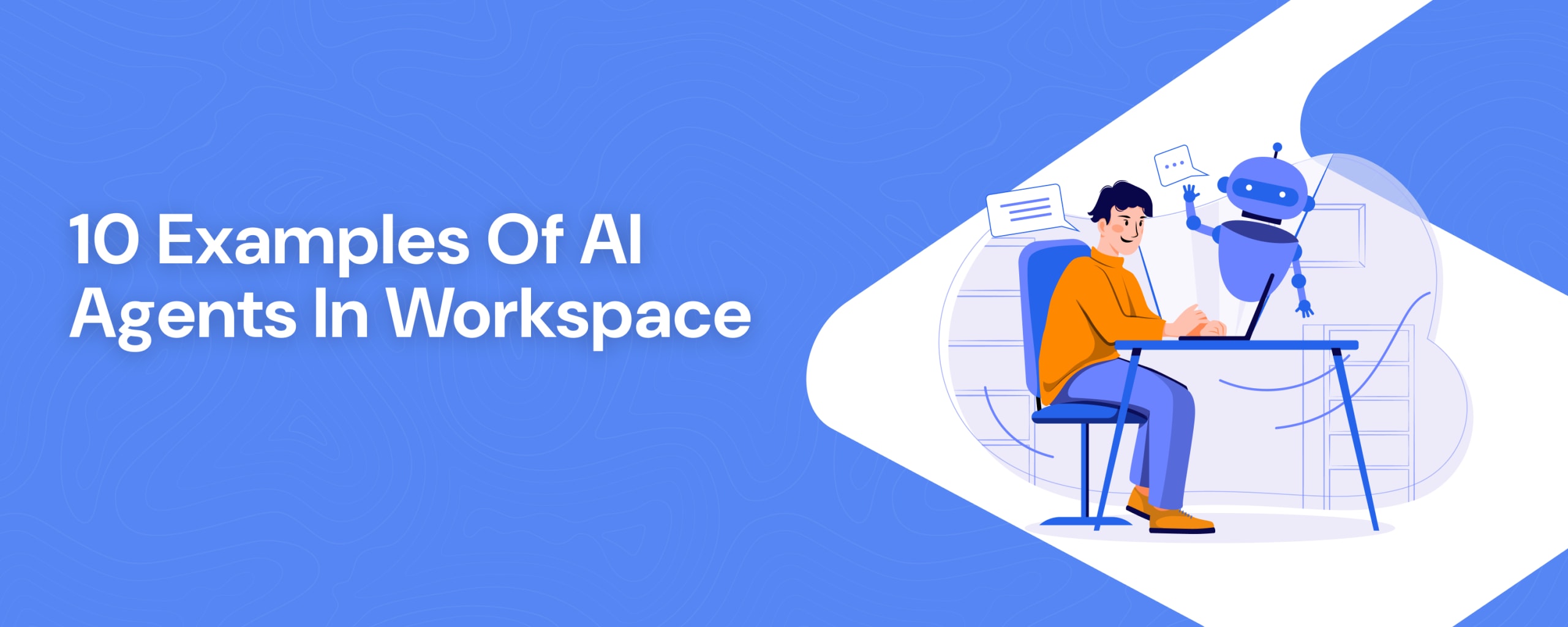AI isn’t the future.
They’re already in your Slack, your inbox… maybe even reading your resume.
While we dream of building sentient beings like C-3PO or J.A.R.V.I.S.—
what we actually have today is something quieter, but game-changing:
AI agents.
- They schedule meetings.
- Scan resumes.
- Draft proposals.
- And get smarter every week—without needing snacks or PTO.
This isn’t hype. It’s happening now.
And in this blog, you’ll see how:
- AI agents think and act independently
- The 10 types you’ll encounter at work
- Real-world use cases from HR, marketing, IT & beyond
If you’re still picturing AI as “just a chatbot,” this will change your mind.
What is an AI agent?
Quick answer: An AI agent is a smart digital assistant that takes a goal, thinks for itself, and gets the task done—like scheduling meetings or answering questions—without needing step-by-step instructions. It’s like a proactive teammate that works on your behalf.
An AI agent is a smart digital helper that can act on its own to get a task done for you.
Instead of waiting for detailed step-by-step instructions, you simply give it a goal—and it figures out the rest.
It observes its environment, makes decisions, and takes action, often without any human supervision.
Imagine telling your AI coworker: “Schedule a team meeting for next week.”
The agent checks everyone’s calendar, picks the best time, books the room, and sends invites—no back-and-forth emails needed.
In short, it’s like a virtual teammate that thinks and acts to help you work faster and smarter.
But like most people initially think AI agents are not Chatbot, both are different.
Here’s the difference:
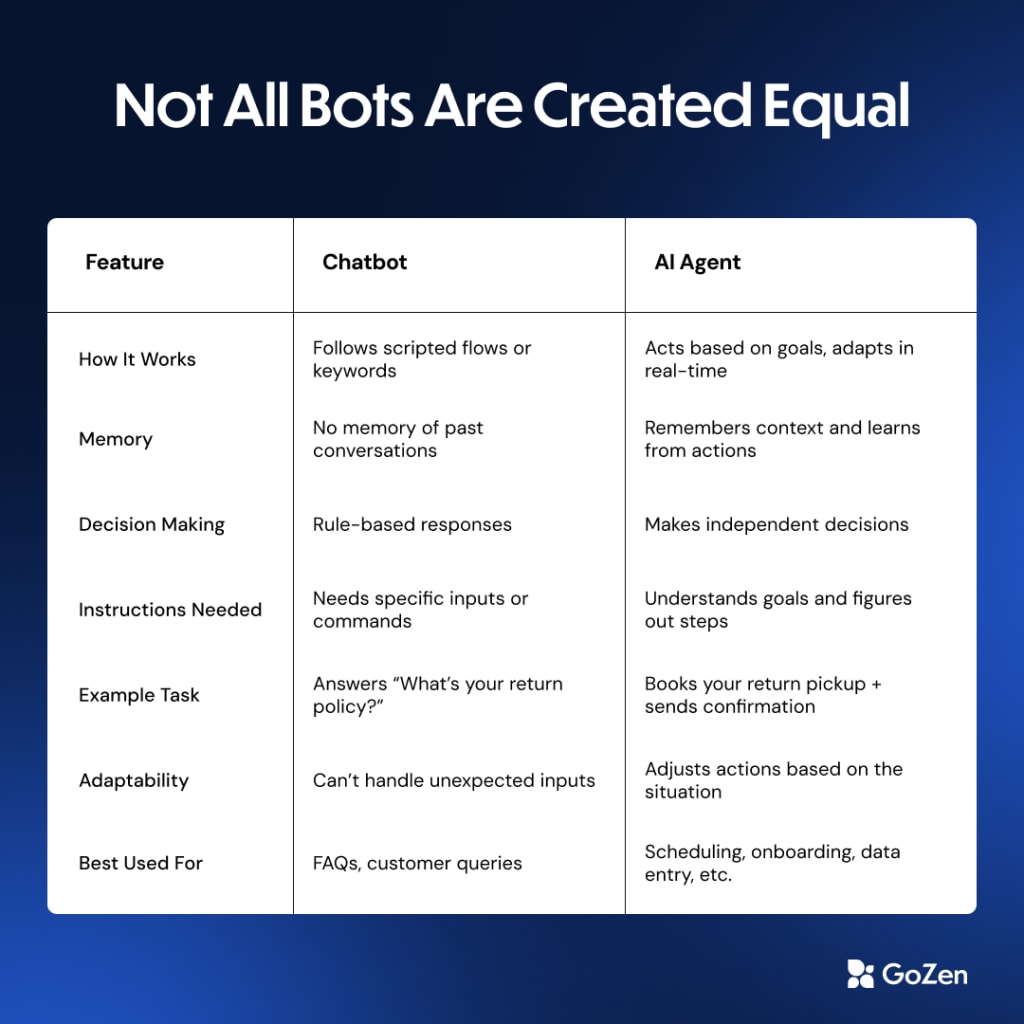
What are the types of AI agents?
Here’s a quick table of it:
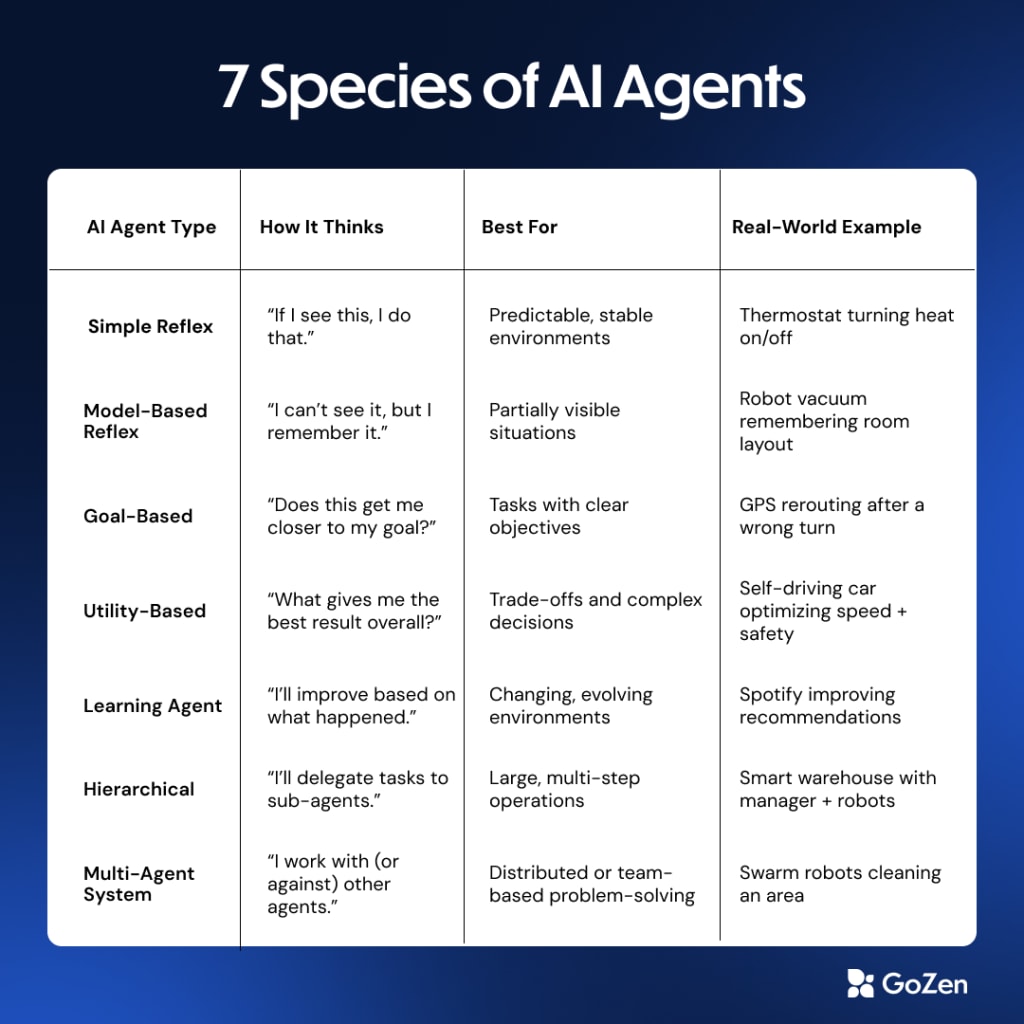
1. Simple Reflex Agents
These agents operate purely on the “see something → do something” principle.
They respond to current inputs using predefined condition-action rules (like “if X, then do Y”), without considering past events or future outcomes.
- How they think: No memory, no learning, no future planning.
- Best for: Stable, predictable environments.
- Example: A basic thermostat that turns the heat on if the temperature drops below 18°C and off if it rises above 22°C. It doesn’t remember what it did before—it just reacts to the moment.
2. Model-Based Reflex Agents
These agents are smarter than simple reflex ones because they build and refer to an internal model of the world.
That means they can make decisions based not only on what they currently sense, but also what they believe is happening behind the scenes.
- How they think: “I can’t see everything, but I can guess based on what I know so far.”
- Best for: Environments that are partially observable (i.e., not all information is visible at once).
- Example: A robot vacuum that remembers the layout of your home and avoids areas it has already cleaned—even if it can’t see them right now.
3. Goal-Based Agents
These agents go beyond reactions—they plan.
They have a goal in mind and evaluate different actions to figure out the best path to get there.
They ask themselves: “Will this action bring me closer to my goal?”
- How they think: They use search algorithms and planning to sequence their steps.
- Best for: Complex decision-making with clear objectives.
- Example: A navigation system that recalculates the best route every time you take a wrong turn. It’s constantly comparing your position to the goal.
4. Utility-Based Agents
Utility-based agents still pursue goals, but they’re picky about how well those goals are achieved.
They use a utility function—a kind of “satisfaction score”—to weigh different options and choose the most beneficial one.
- How they think: “What’s the best outcome I can get out of this?”
- Best for: Scenarios with trade-offs, uncertainty, or multiple competing objectives.
- Example: A self-driving car that chooses routes based on safety, speed, and fuel efficiency. It might avoid faster roads if they’re riskier.
5. Learning Agents
These agents adapt and improve over time.
They observe the results of their actions, learn from successes and mistakes, and update their strategies accordingly.
They often use machine learning methods like supervised learning, reinforcement learning, or unsupervised learning.
- How they think: “I didn’t get it right last time, so I’ll try something better now.”
- Best for: Dynamic environments where things change and past experience can help improve future performance.
- Example: A music streaming app that refines your song suggestions the more you use it, based on what you like or skip.
6. Hierarchical Agents
These agents break down complex tasks into smaller parts.
Higher-level agents define broader goals or tasks, and delegate to lower-level agents that handle the details.
This structure allows for greater scalability and specialization.
- How they think: Like a company CEO giving tasks to department heads, who then assign them to individual employees.
- Best for: Multi-step or complex systems where responsibilities need to be split and managed efficiently.
- Example: A smart warehouse where a supervisor AI coordinates multiple robot agents—some manage shelf restocking, others handle item picking, and others optimize delivery.
7. Multi-Agent Systems (MAS)
In these systems, multiple AI agents work either together (cooperative) or against each other (competitive) to achieve individual or shared goals.
Each agent may have different roles, information, or capabilities.
- How they think: “I’m not alone here—I need to collaborate or compete.”
- Best for: Distributed tasks, complex simulations, or systems with multiple moving parts.
- Example: Swarm robots that communicate to clean an area together, or financial trading bots competing in a market environment.
What are the examples of AI agents in workplace?
Here are the 10 examples of AI agents in workplace:
- AI Customer Support Chatbot
- AI Sales Assistant (Virtual SDR)
- AI Analytics Assistant (Marketing Analyst)
- AI Content Writer (Marketing/HR/Docs)
- AI Meeting Scheduler (Calendar Assistant)
- AI HR Recruiter (Talent Screener)
- AI IT Helpdesk Assistant
- AI Coding Assistant (Dev Buddy)
- AI Security Monitoring Agent
- AI Inventory and Supply Chain Agent
1. AI Customer Support Chatbot
What it does: Handles common customer questions through chat or voice.
It can pull answers from help docs, troubleshoot basic issues, and escalate complex cases to humans.
Problem it solves: Long wait times and overwhelmed support teams handling repetitive queries like “Where’s my order?”
Scenario: You ask about a refund at midnight—an AI agent replies instantly with the steps, no human involved.
Upside: 24/7 instant responses, lower support costs, and less burnout for human agents.
2. AI Sales Assistant (Virtual SDR)
What it does: Sends emails/texts to leads, answers common sales questions, and books meetings when a lead seems interested. Also scores leads based on data.
Problem it solves: Sales reps waste hours chasing cold leads or forgetting to follow up.
Scenario: Download a whitepaper → get a friendly email from “Alex the AI rep” → it keeps checking in until you’re ready.
Upside: No lead falls through the cracks. Salespeople focus only on warm prospects. .
3. AI Analytics Assistant (Marketing Analyst)
What it does: Monitors KPIs (like traffic or conversions), spots spikes or dips, and notifies teams with insights.
Problem it solves: Teams drown in dashboards but miss important trends or anomalies.
Scenario: The AI notifies you that blog traffic jumped 20% overnight—likely from a viral post.
Upside: Faster, data-informed decisions without manual digging.
4. AI Content Writer (Marketing/HR/Docs)
What it does: Writes blog drafts, emails, product descriptions, reports, etc., based on a prompt and tone guide.
Problem it solves: Writer’s block and content overload.
Scenario: A marketer needs a 1,000-word post by EOD. The AI drafts it in minutes.
Upside: Speeds up content creation by 60%, freeing humans for strategy and editing.
5. AI Meeting Scheduler (Calendar Assistant)
What it does: Finds the best time to meet, sends invites, reserves rooms, and handles time zones.
Problem it solves: Endless back-and-forth emails just to pick a time.
Scenario: CC the AI in an email and say, “Find a time for us.” It takes over.
Upside: Saves hours of admin work. One tool claims to give teams 40% more focus time.
6. AI HR Recruiter (Talent Screener)
What it does: Scans resumes, ranks candidates, answers applicant FAQs, schedules interviews, and even does video assessments.
Problem it solves: Manual resume screening takes forever and introduces human bias.
Scenario: 500 resumes → AI shortlists the top 50 in seconds → sends tests automatically.
Upside: Faster hiring. Unilever saved 100,000+ recruiter hours and $1M/year using AI.
7. AI IT Helpdesk Assistant
What it does: Troubleshoots tech issues via chat, resets passwords, unlocks accounts, and creates support tickets.
Problem it solves: IT teams get flooded with repeat issues.
Scenario: You say “Can’t connect to VPN” in chat—AI diagnoses and sends a fix instantly.
Upside: Cuts IT workload drastically and reduces employee downtime.
8. AI Coding Assistant (Dev Buddy)
What it does: Autocompletes code, suggests snippets, finds bugs, and generates entire functions.
Problem it solves: Developers waste time on boilerplate code and debugging.
Scenario: Dev types “sort by sign-up date,” and the AI fills in the rest.
Upside: Speeds up coding by ~30%, keeps devs in flow, and reduces errors.
9. AI Security Monitoring Agent
What it does: Monitors systems for anomalies, detects cyber threats, and sometimes acts (blocks access, isolates devices).
Problem it solves: Human analysts can’t watch every event; traditional tools miss novel attacks.
Scenario: Detects suspicious downloads at 3 AM → flags the activity and blocks it.
Upside: Instant threat detection and response. Darktrace uses immune-system-style AI for this.
10. AI Inventory and Supply Chain Agent
What it does: Tracks stock, predicts demand, reorders automatically, and adjusts pricing dynamically.
Problem it solves: Overstock drains cash; stockouts lose sales.
Scenario: Detects a rainstorm → ships more umbrellas to that region instantly.
Upside: Better forecasts and fulfillment. Coca-Cola saw 20% improvement in demand accuracy using AI.
These AI agents don’t just “automate”—they think, adapt, and make business operations smarter and faster.
What are the examples of real-life companies using AI agents in their workplace?
Here are the 10 examples of companies using AI agents in their workplace:
- GoZen – Uses AI-powered content creation and repurposing agents for social media marketing.
- IBM – Uses internal process automation agents for data entry, transactions, and operations.
- Iron Mountain – Uses Salesforce Einstein AI to assist customer support reps in real time.
- Unilever – Uses AI recruiting agents for resume screening and video interview analysis.
- Coca-Cola – Uses AI supply chain agents for demand forecasting and stock optimization.
- The Washington Post – Uses Heliograf, an AI content generator for automated news writing.
- Deutsche Telekom – Uses the askT AI agent to handle internal employee support and knowledge queries.
- Uber – Uses AI agents across support, onboarding, and engineering for productivity gains.
- Cosentino – Uses AI credit management agents for order processing and risk assessment.
- eBay – Uses AI shopping assistants for personalized product recommendations and guided buying.
1. GoZen Technologies
Use case: AI powered Social media content creation agent
Tasks handled: Idea generation, research, content creation and repurposing.
Impact:
- A month’s worth of social media content completed in 30 minutes.
- Gave time for marketers to focus on creative and strategic aspects and other critical campaigns like GTM.
2. IBM
Use Case: AI-powered bots for internal process automation.
Tasks handled: Data entry, transaction processing, order handling.
Impact:
- Saved employee time,
- Improved accuracy, and let teams focus on strategic work instead of repetitive chores.
3. Iron Mountain
Use Case: Customer support AI using Salesforce Einstein.
Agent role: Suggests replies and knowledge base articles to support reps.
Impact:
- 8% drop in repeat customer calls
- 10% faster average handling time
- 70% fewer chat abandonments = more efficient support and less customer frustration.
4. Unilever
Use Case: AI agents in recruiting.
Agent tasks: Screen resumes, analyze video interviews, assess candidate fit.
Impact:
- Saved over 100,000 hours of human recruiting time
- Cut hiring costs by ~$1M/year
- Increased diversity by reducing bias in early-stage hiring.
5. Coca-Cola
Use Case: Inventory forecasting and supply chain optimization.
Agent tasks: Analyzes sales + IoT data, predicts demand, adjusts stock.
Impact:
- Improved demand forecast accuracy by 20%
- Better product availability during events and seasonal peaks = happier customers, less waste.
6. The Washington Post
Use Case: AI content generator called Heliograf.
Agent job: Creates news briefs and social updates from structured data (like sports scores or election results).
Impact:
- More content output without more staff
- Journalists freed up for deep, investigative stories
These examples show that AI agents aren’t just futuristic — they’re already helping teams work smarter and faster today.
7. Deutsche Telekom – Employee Knowledge Assistant
Use Case: Internal Employee Support
Agent Job: The askT AI agent acts as an intelligent concierge for employees.
It answers queries about company policies, benefits, and products, handles HR requests like leave submissions, and gives instant access to a knowledge base spanning 200,000+ documents.
Impact:
- Reduced employee search time from minutes to just 18 seconds.
- Enabled customer care agents to answer inquiries instantly and accurately.
- Streamlined HR tasks like leave requests and policy queries.
8. Uber – Workplace Productivity and Operations
Use Case: Operational Efficiency Across Functions
Agent Job: Uber uses AI agents in customer support automation, driver onboarding (e.g., document verification, background checks), and engineering (e.g., AI-assisted coding tools).
Impact:
- 67% productivity boost for engineers
- Faster detection and resolution of operational issues
- Simplified onboarding and engineering processes across 2,200+ engineers in India
9. Cosentino – Credit Management and Customer Service
Use Case: Sales Order Processing & Risk Management
Agent Job: The AI agent manages credit blocks by analyzing sales orders, evaluating customer creditworthiness, and recommending next actions (e.g., unblock orders, request more docs).
Impact:
- Blocked orders processed 5× faster
- Enhanced risk compliance with dramatically reduced manual workload
10. eBay – E-commerce Shopping Assistance
Use Case: Personalized Shopping Experience
Agent Job: The AI shopping assistant offers real-time, personalized product recommendations, predicts shopper needs, and guides users through their purchase journey with expert-like interaction.
Impact:
- Hyper-personalized suggestions
- Real-time engagement and predictive messaging
- Enhanced global shopper experience across millions of users
AI Agents are everywhere and it ain’t stopping
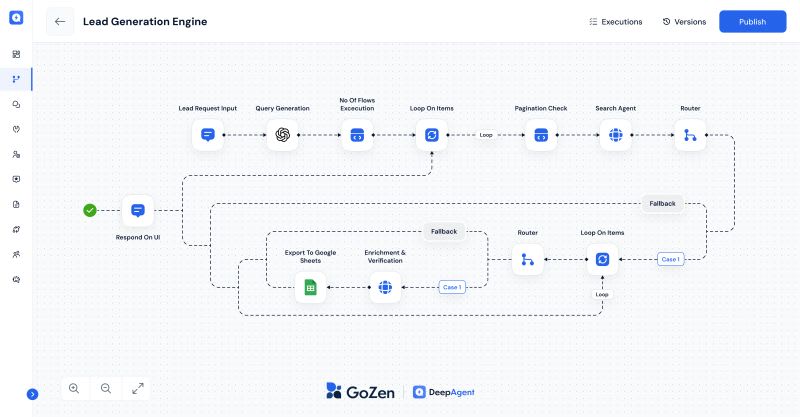
Open LinkedIn and you’ll see it everywhere — people showing off their AI agents.
Some are pretty impressive too. Like mini sales or marketing teams agents.
A year ago, AI videos looked weird. Now?
Google’s Veo 3 is pumping out videos that feel like they’re shot on a real camera.
Soon — maybe this year — AI agents will completely handle all your grunt work.
Like a free, smart assistant working in the background.
Feels like we’re inching into ‘I Robot’ territory.
Let’s just hope we don’t need a Will Smith moment to fix things.
Do AI agents make careers obsolete?
Short answer: No, but they will change how you work.
AI agents aren’t here to steal your job—they’re here to take over the boring stuff so you can focus on what humans do best: thinking creatively, solving complex problems, and connecting with people.
Interesting thing is, In early 2023 IBM replaced thousands of employees with AI, but surprisingly they hired equally to what they replaced.
IBM’s CEO says, “While we’ve done a tremendous amount of work to leverage AI, our total employment has actually increased because it’s allowed us to invest more in other areas.
Here’s What’s Really Happening:
- AI agents excel at repetitive tasks. They’re great at scanning resumes, scheduling meetings, or answering routine customer questions.
- But most jobs are a mix. If 25% of your tasks are automatable, the other 75%—strategy, creativity, empathy—still need you.
- Your role shifts. You’ll likely collaborate with AI, manage it, or train it — like a marketer prompting a content AI or a support rep coaching a chatbot.
AI also creates jobs:
- Prompt engineers
- AI workflow designers
- Data trainers
- Human-AI collaboration managers
AI agents aren’t your replacements.
They’re your turbocharged teammates.
Use them to offload the tedious work—then double down on the skills no bot can match like human connection and creativity.
Building AI agents was hard – Not anymore.
Usually, building an AI agent is pretty complex; it’ll be easy if you’re into techy stuff and like to play with it for long hours,
But if you’re like me, more into creative work, you hate complex stuff.
That’s how most AI agent builders are—until this one arrives.
DeepAgent.
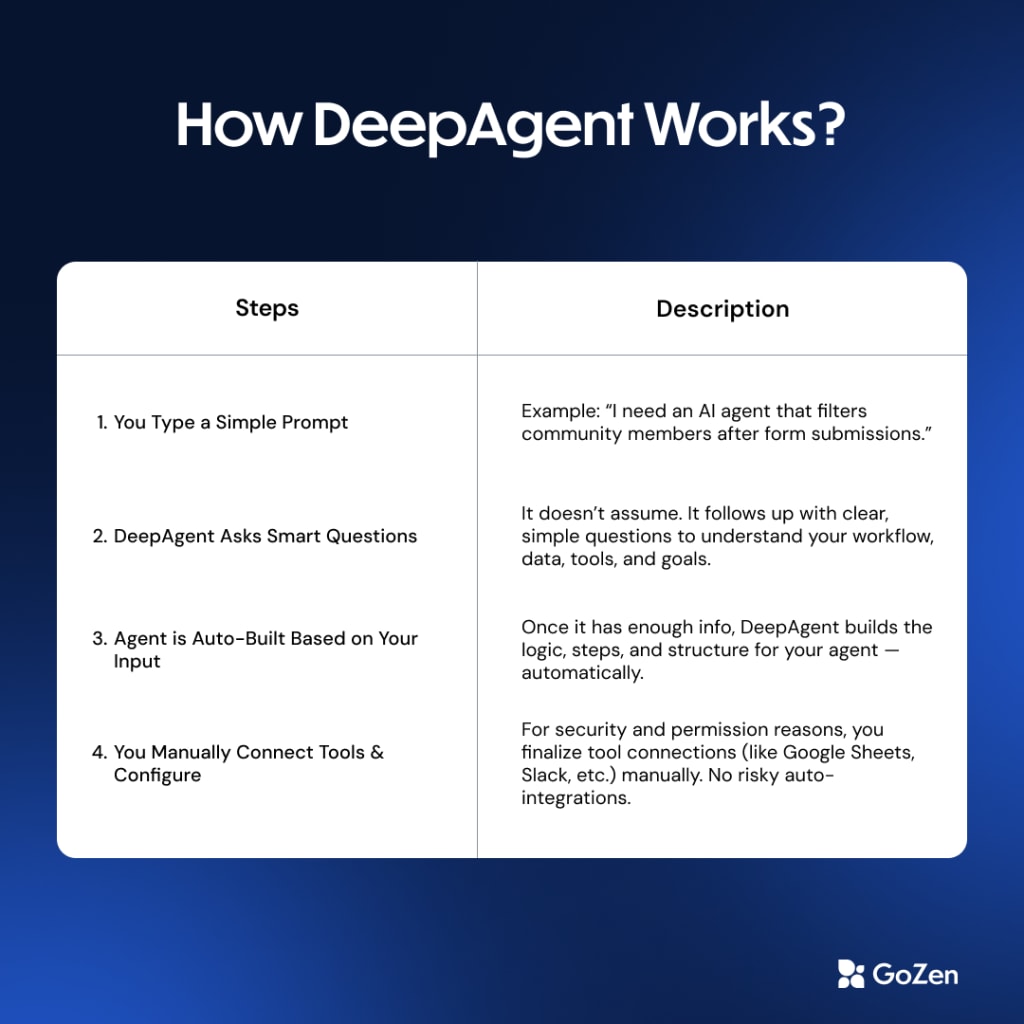
All you have to do is text it, like you do with ChatGPT, asking the exact kind of AI agent to automate your repetitive and boring job.
Boom – It’ll create your exact AI agent in minutes, not hours.
If your company is serious about adopting AI agents into its workflow, this is the only AI agent builder you have to consider.
Learn more about DeepAgent here.
FAQ
What are the 5 types of agents in AI?
1. Simple Reflex Agents: Act right away based on current input using set rules. They don’t remember or learn.
Example: A thermostat that turns the heat on or off depending on the room temperature.
2. Model-Based Reflex Agents: Use a small map or memory to understand what’s going on now and what happened before. This helps in places where they can’t see everything.
Example: A robot vacuum that remembers the room layout and avoids bumping into things.
3. Goal-Based Agents: Make plans to reach a goal. They think ahead and choose actions that help them get there.
Example: A self-driving car that plans the best route to a place while avoiding traffic or crashes.
4. Utility-Based Agents: Pick the action that gives the most benefit or best result. They look at what’s most useful.
Example: Netflix showing you movies and shows you’ll probably enjoy the most.
5. Learning Agents: Learn and get better over time by using experience and feedback.
Example: AlphaGo, which got really good at the game Go by studying lots of past games.
Is Siri an AI agent?
Yes, Siri is an AI assistant from Apple that do simple tasks and obey commands from the user. Because it does the tasks without human having to tell instructions step by step, It’s an AI agent.
Is ChatGPT an AI agent?
No, ChatGPT is not an AI agent.
ChatGPT is a very advanced AI that’s great at understanding and writing text like a human.
It has some things in common with AI agents—like understanding language and keeping track of what’s being talked about.
But it doesn’t set its own goals or act on its own, which real AI agents do. It’s more like a smart helper that works with you, not by itself.
So, ChatGPT is not an AI agent.
How are companies using AI agents?
Companies are using AI agents for both big-picture plans and everyday tasks.
For strategy, they use AI to understand complex data and make smart decisions about where the company should go.
One China-based company, NetDragon Websoft, even made an AI the CEO to help with these big choices.
For daily work, companies use AI to handle boring, repetitive jobs—like answering the same customer questions over and over, or doing technical SEO tasks in marketing.
